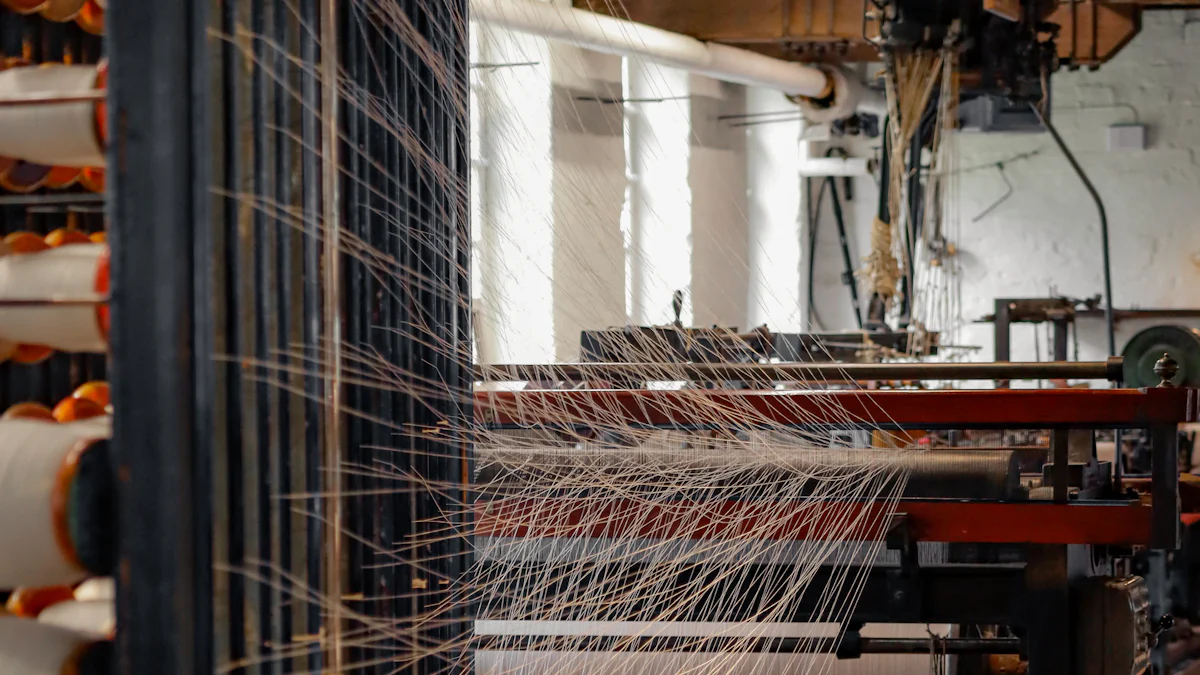In 2025, desizing agents redefine how textiles are processed. You can now achieve faster production cycles while reducing environmental impact. These agents remove sizing materials from fabrics with precision, ensuring cleaner and more efficient workflows. By adopting these solutions, you contribute to a sustainable future and improve the overall quality of textile manufacturing.
Understanding DESIZING AGENTS in Textile Processing
What Are DESIZING AGENTS?
Desizing agents are specialized substances used to remove sizing materials from fabrics. Sizing materials, such as starch or synthetic polymers, are applied during weaving to strengthen yarns and improve their performance. However, these materials must be removed before dyeing or finishing to ensure the fabric absorbs color evenly. Desizing agents break down these materials, making them easier to wash away. By using these agents, you can prepare fabrics for the next steps in textile production with precision and efficiency.
Why Removing Sizing Materials Is Crucial
Removing sizing materials is essential for achieving high-quality textiles. If these materials remain on the fabric, they can block dyes and chemicals from penetrating the fibers. This results in uneven coloring and poor fabric performance. Desizing ensures that the fabric is clean and ready for dyeing, printing, or finishing. It also prevents defects in the final product, saving you time and resources. Additionally, proper desizing reduces the environmental impact of textile production by minimizing waste and improving water treatment processes.
Types of DESIZING AGENTS in Use Today
You can choose from several types of desizing agents based on your production needs. Enzymatic desizing agents, such as amylases, are popular for their eco-friendly properties. They break down starch-based sizing materials without harming the fabric. Oxidative agents, like hydrogen peroxide, are effective for synthetic sizing materials. Chemical desizing agents, including acids and alkalis, offer fast and efficient results. Each type has unique benefits, allowing you to select the best option for your specific application.
Innovations in DESIZING AGENTS Technology in 2025

Enzymatic Solutions for Sustainable Processing
Enzymatic solutions have become a game-changer in textile processing. These solutions use natural enzymes, such as amylases, to break down starch-based sizing materials. You can rely on these enzymes to deliver precise results without damaging the fabric. Enzymatic desizing also reduces the need for harsh chemicals, making it an eco-friendly choice. By adopting these solutions, you lower water consumption and minimize waste, contributing to a greener production process. Many manufacturers now prefer enzymatic desizing for its ability to balance efficiency with sustainability.
Advanced Chemical Formulations for Enhanced Efficiency
Chemical formulations in 2025 have reached new levels of efficiency. Modern DESIZING AGENTS now include advanced blends that target synthetic sizing materials with precision. These formulations work faster and require less water, helping you save time and resources. For example, oxidative agents like hydrogen peroxide have been optimized to deliver consistent results. You can achieve high-quality desizing while reducing operational costs. These innovations ensure that your production process remains competitive in a fast-paced industry.
Smart Technologies in Desizing Applications
Smart technologies are revolutionizing how you apply DESIZING AGENTS. Automated systems now monitor and control the desizing process in real time. Sensors detect fabric conditions and adjust the application of agents for optimal results. This reduces errors and ensures uniform desizing across all fabrics. You can also integrate these systems with data analytics to track performance and identify areas for improvement. Smart technologies not only enhance efficiency but also make your operations more reliable and scalable.
Tip: Combining enzymatic solutions with smart technologies can maximize both sustainability and efficiency in your textile production.
Benefits of DESIZING AGENTS in Modern Textile Manufacturing

Boosting Production Efficiency and Reducing Costs
You can significantly improve production efficiency by using desizing agents. These agents streamline the process of removing sizing materials, reducing the time required for fabric preparation. Faster processing means you can handle larger production volumes without delays. Additionally, desizing agents help minimize fabric defects, which lowers the need for rework.
Cost savings are another major benefit. By optimizing the desizing process, you use fewer resources like water and energy. This reduces operational expenses. Modern desizing agents also work effectively at lower temperatures, cutting down on energy costs. When you adopt these solutions, you not only save money but also enhance your production capabilities.
Environmental Advantages: Lower Water and Energy Usage
Desizing agents play a crucial role in making textile manufacturing more eco-friendly. Many of these agents are designed to work efficiently with less water. This reduces the strain on water resources and helps you meet sustainability goals. Enzymatic desizing agents, in particular, are biodegradable and require minimal rinsing, further lowering water consumption.
Energy usage also decreases when you use advanced desizing agents. Some formulations work at ambient temperatures, eliminating the need for heating. This reduces your carbon footprint and aligns your operations with environmentally responsible practices. By choosing sustainable desizing solutions, you contribute to a cleaner planet.
Note: Switching to eco-friendly desizing agents can improve your brand’s reputation as a sustainable manufacturer.
Improved Fabric Quality and Longevity
Desizing agents ensure that your fabrics are free from residual sizing materials. This improves the fabric’s ability to absorb dyes and chemicals evenly, resulting in vibrant and consistent colors. You can achieve superior-quality textiles that meet customer expectations.
Proper desizing also enhances the durability of fabrics. Residual sizing materials can weaken fibers over time, leading to wear and tear. By removing these materials, you extend the lifespan of your products. This not only satisfies your customers but also reduces waste in the long run. High-quality, long-lasting fabrics give you a competitive edge in the market.
Real-World Success Stories with DESIZING AGENTS
Case Study: Jindun Chemical’s TRANSIGEN JD-127A and JD-127B
Jindun Chemical has set a benchmark in textile processing with its TRANSIGEN JD-127A and JD-127B desizing agents. These products deliver exceptional results by effectively removing sizing materials while preserving fabric integrity. You can rely on these agents to prepare fabrics for dyeing and finishing with unmatched precision.
TRANSIGEN JD-127A works best for natural fibers, ensuring thorough desizing without damaging delicate materials. JD-127B, on the other hand, targets synthetic fibers, offering superior performance for polyester and blends. Both agents reduce water usage and operate efficiently at lower temperatures. This makes them ideal for manufacturers aiming to cut costs and adopt sustainable practices.
Success Insight: Many textile companies using TRANSIGEN JD-127A and JD-127B have reported a 20% reduction in water consumption and a noticeable improvement in fabric quality.
Industry Trends in Sustainable Desizing Practices
Sustainability has become a priority in textile manufacturing. You’ll notice a growing shift toward enzymatic desizing agents due to their eco-friendly properties. Many manufacturers now combine enzymatic solutions with advanced water recycling systems to minimize waste.
Another trend involves adopting low-temperature desizing agents. These formulations reduce energy consumption, helping you lower your carbon footprint. Smart technologies also play a role, enabling real-time monitoring to optimize resource usage.
Lessons from Implementing Advanced Desizing Solutions
When adopting advanced desizing agents, you should focus on staff training. Proper handling ensures consistent results. Start by testing new agents on small batches to evaluate their performance.
Integrating smart systems can further enhance efficiency. Automated controls help you reduce errors and maintain uniformity. By embracing these solutions, you’ll achieve higher productivity and meet sustainability goals.
Desizing agents redefine textile manufacturing by improving efficiency, sustainability, and fabric quality. You can meet modern industry demands with these advanced solutions. Their innovative technologies reduce costs and environmental impact. By adopting them, you gain a competitive edge while contributing to a greener planet. These agents represent the future of responsible textile production.
Post time: Jan-14-2025

